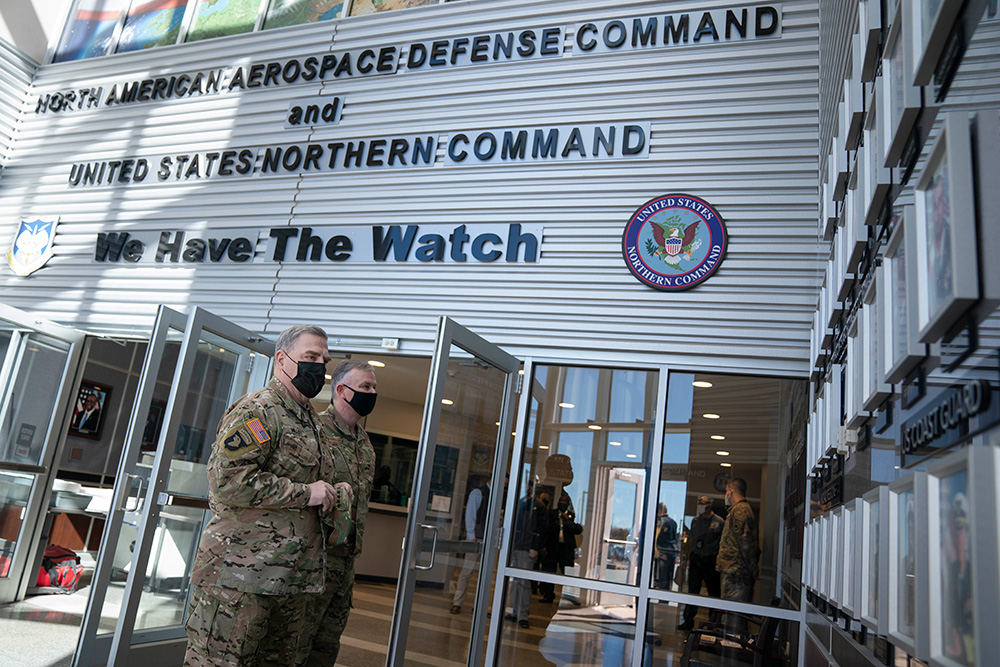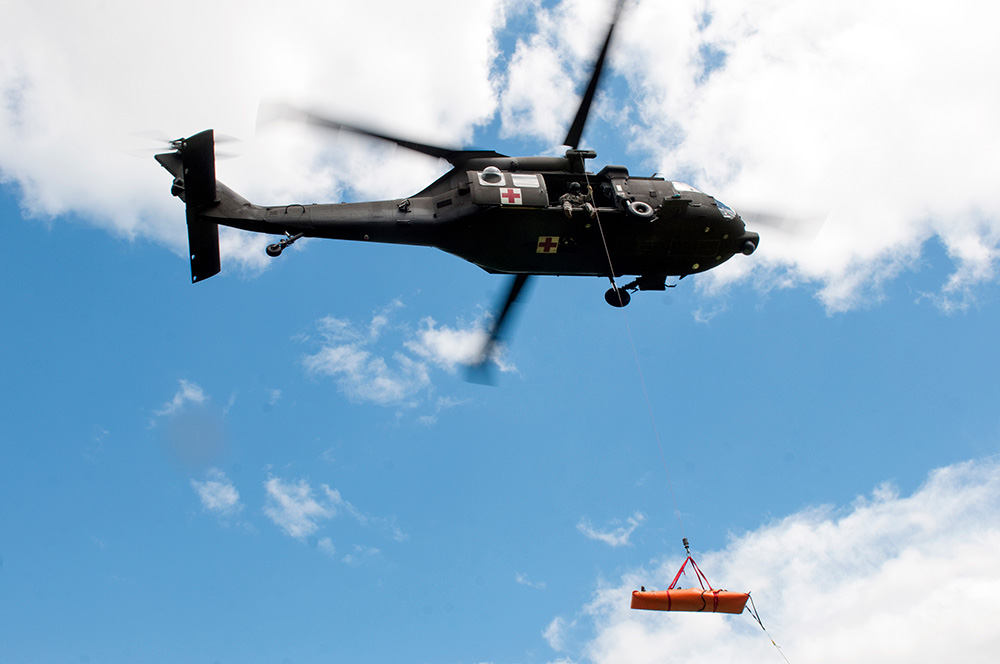U.S. Northern Command is responsible for defending the U.S. homeland against threats from adversaries—and there are many such threats, said Air Force Gen. Glen D. VanHerck, who serves as commander of both Northcom and the North American Aerospace Defense Command.
During U.S. operations in the Middle East, China and Russia watched how the U.S. operated and developed their own systems that put the U.S. at risk.
“While we were focused on violent extremists for last 20-plus years, they were developing capabilities to hold our homeland at risk,” said VanHerck, who spoke Tuesday at the Association of the United States Army’s annual meeting and exposition in Washington, D.C.
The general said that while both nations have developed systems to put the U.S. at risk, but he characterized Russia as the primary threat to the U.S. homeland right now.

Air Force Gen. Glen D. VanHerck, commander of both U.S. Northern Command and the North American Aerospace Defense Command, right, walks with Army Gen. Mark A. Milley, chairman of the Joint Chiefs of Staff at Northcom and NORAD headquarters, Peterson Air Force Base, Colo., March 1, 2021. © Navy Petty Officer 1st Class Carlos M. Vazquez II
“About three to four years ago, Russia fielded the first hypersonic glide vehicle sitting on top of an ICBM [intercontinental ballistic missile] that’s nuclear capable,” he said. “It’s been out there for, you know, four years operational, with the United States of America and North America in its sights.”
Those missiles, he said, make the U.S. northern warning system “look like a picket fence,” the general said.
Russian submarines, he added, particularly of the Severodvinsk class are set to become a threat, as well.
“They just moved subs, their first [Severodvinsk] into the Pacific,” he said. “Another [Severodvinsk] is out in the Mediterranean right now and another that’s out on its way into the Atlantic. That will be a persistent, proximate threat capable of carrying a significant number of land-attack cruise missiles that can threaten our homeland.”
China isn’t far behind Russia’s ability to directly affect the U.S. homeland — about seven to 10 years, VanHerck said. But both nations are active in the Arctic, which is an easy way to attack the U.S., and he also characterized both China and Russia as peer competitors in both space and the cyber domain.
VanHerck said defending the homeland against existing threats, growing threats and future threats will mean his own command needs to do things differently. One of those changes is the speed at which sensor-to-decision maker data moves between stakeholder.
“Data and information are strategic assets that we need to take advantage of now,” he said. “Google, Amazon, others have figured out how to share data and information. What we need to be focusing on is making our data available, not in stovepipes, and being able to receive that data.”
Assignment of forces to Northcom can also be quicker and more efficient, VanHerck said.
“I think there’s things that we can do as a department, and I’m encouraged where we’re going. The Global Force Management implementation guidance will give me some additional help with having forces that are available to me in a timely manner,” he said. “What I told the secretary is one of my biggest challenges with executing my [contingency] plans and [operations] plans is access to organized, trained and equipped forces in a timely manner to operate through my AOR [area of responsibility].”
Right now, he said, more than half of the Northcom area of responsibility is in the Arctic, though forces are not organized, trained or equipped to operate there.

An HH-60M Black Hawk helicopter hoists a simulated casualty during exercise Vigilant Guard 2016 at Camp Ethan Allen Training Site, Jericho, Vt., July 29, 2016. The exercise is a national emergency response exercise sponsored by the National Guard and U.S. Northern Command. © Army Spc. Avery Cunningham, National Guard
When Northcom requests forces through the “request for forces” process, VanHerck said, consideration is also given to the needs of other combatant commands, such as U.S. Indo-Pacific Command, U.S. European Command] and U.S. Strategic Command, for instance. There may be other needs that end up overriding what Northcom needs.
“That adds risk in the time of crisis,” he said. “I think we need forces that look vastly different than what we have today, that reduce the demand for tankers, that reduce the demand for fighters. And what I’m talking about is autonomous and unmanned systems.”
VanHerck said he envisioned a future where unmanned systems might be parked “off the coast” near some of the threats to the homeland, and that those same unmanned systems would have domain-awareness capabilities and might also be armed with both kinetic and non-kinetic weaponry.
“Think of [position navigation timing] denial and deception or high-power microwave or laser capabilities,” he said. “Now, I’m not asking for all the fighters that are competing directly with [Indo-Pacom] or [Eucom]. And I don’t need all the tankers for that, if we position those in key locations around the country. The same thing can be said for autonomous air platforms that give me domain awareness, that can loiter for 18, 24 hours and beyond, that provide domain awareness, but they also provide potentially that kinetic effect or non-kinetic effect.”
Right now, VanHerck said his vision appears to be science fiction. But he said he thinks it would become possible in less than a decade.
“Those are things that we need to be thinking about.”





